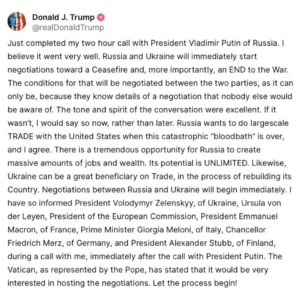Encirclement: Trump Resets U.S.-Russia Relations

Background Recap: From Dual Pivots to Trump’s Breakthrough
My previous analysis framed U.S.-China competition as a battle over two pivotal arenas: Russia and the South China Sea. It’s a high-stakes geopolitical showdown—control these key nodes, and you dictate the Indo-Pacific and global order for decades.
I predicted that whether Trump could quickly pull Russia into his orbit and keep it from dragging its feet would be his first big strategic test. Now, Trump’s two-hour call with Putin on May 19, 2025, pushing Russia-Ukraine peace talks with Vatican involvement, shows Russia—one of the dual pivots—is starting to budge. The balance is breaking. Trump’s not just the guy flipping this pivot; he’s stepping up as a peacemaker, showing off his geopolitical chops.
Trump’s Breakthrough: Wooing Russia with Peace and Economic Carrots
Trump’s offered restored energy trade, sanctions relief, and a spot in global supply chain shifts to get Russia to rethink its position.
This isn’t just about peace—it’s a full-on geopolitical restructuring. The dual-pivot setup is falling apart, and the Russia-China back-to-back alignment is crumbling. From energy to food to financial pipelines, Russia’s quietly leaning toward the U.S., putting major heat on China.
Geopolitical Shift: Dual Pivots Collapse, Encirclement Takes Shape
Traditional U.S. diplomacy sticks to a “divide and conquer” playbook within existing alliances, playing the steady anchor in a predictable system. It’s consistent but often clueless about changing realities. Politics is all about timing, and as the world shifts, sticking to outdated strategies is a dead end.
Today’s U.S.-China clash stems from the 1970s “team up with China, contain the Soviets” policy, which wasn’t tweaked after the Soviet Union fell apart. America’s soft touch with China fueled its rise as a top rival, while U.S.-Russia bad blood lingered. Even though the Cold War’s over and Russia’s ditched communism, the global system’s inertia kept casting it as the West’s bad guy.
Trump gets this. He doesn’t build on busted foundations but reshuffles alliances based on today’s geopolitical reality. Diplomacy’s still about “divide and conquer,” but the real difference is scrapping old Cold War baggage. He’s not just balancing power like a realist; he’s defending a conservative vision of order and civilizational lines.
In the Russia-Ukraine peace talks, with Pope Leo XIV offering the Vatican as a neutral venue, Trump’s strategy is on full display. If he nails a ceasefire and flips Russia, the Russia-China alliance will take a nosedive, and the dual-pivot game will be done.
With Russia going neutral or even leaning U.S., a sea-land encirclement of China is taking shape:
- Sea Route: The U.S., Japan, Australia, India, and the First Island Chain form a naval chokehold, ramping up pressure on China’s moves in the South China Sea, Taiwan, and the East China Sea through joint drills, defense pacts, and deployments.
- Land Route: If Russia stops being China’s strategic backup, it won’t put up with Belt and Road creeping into Central Asia. Russian oil, gas, and raw materials will flow from Far East ports to Japan, South Korea, and Taiwan, cutting their reliance on South China Sea routes and squeezing China further.
This turns the Indo-Pacific encirclement from a one-sided naval blockade into a full-on sea-land stranglehold.
Reassessing the South China Sea: China Ditches Military Gambits
This sea-land pressure will force China to slow its roll in the Taiwan Strait and South China Sea. Its hardline plays—military buildups, gray-zone tactics, or controlled escalations—will get pushed to the sidelines. The U.S. isn’t just hitting China with naval power but pinching it from the Eurasian heartland via Russia.
Under this squeeze, China will likely skip straight-up military clashes and fall back on old-school moves: diplomacy, propaganda, infiltration, and payoffs.
- Doubling down on political sway and stirring up division.
- Pushing frameworks like the “South China Sea Code of Conduct” to control the narrative.
- Throwing cash at infrastructure and economic deals to win over smaller players.
This means the Taiwan Strait and South China Sea won’t be war zones. Hot-war risks aren’t gone, but they’re fading fast. Trump’s building peace.
Conclusion: Trump as Geopolitical Architect and Peacemaker
Trump’s move marks a massive shift in U.S. geopolitics: no more sleepwalking through Cold War patterns, but crafting a new anti-China framework. If the Russia-Ukraine ceasefire, backed by Vatican-hosted talks, lands soon, the vague “dual pivot” contest will turn into a clear “sea-land encirclement,” reshaping U.S.-China-Russia dynamics and the global chessboard.
More than that, Trump’s not just a brawler. His restructuring pulls off a double “de-escalation” win: first, driving a Russia-Ukraine ceasefire; second, cooling tensions in Taiwan and the South China Sea, forcing China to play softer. This makes him both a tough-as-nails strategist and a peacemaker.
How will China handle this shift from “dual pivots” to “encirclement”? What roles will others play? I’ll keep tracking and breaking it down.
